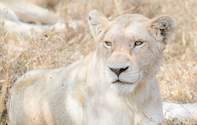
White lions are easier seen in protected environments than in the wild, and The Kingdom of the White Lion Park in Broederstroom near Hartbeespoort is home to a small population of the unique species. For unplanned sightings of the white lions, the Sanbona Wildlife Reserve in the Little Karoo, Western Cape, protects South Africa's only free-range population.
The reserve breeds the lions and prepares them for their release into the wild. The conservation programme aims to reintroduce the species, whose lightened colour is a result of a rare recessive gene, back into the wild. In 2013, only 7 lions were recorded as being free-roaming in the wild in South Africa.
Various monitored activities allow the public to be in contact with captive-bred white lions, in the form of walking or petting encounters.
The White Lion Reintroduction Project was started in 2001 by the Global White Lion Protection Trust (GWLPT). Continuous research has led to increased awareness initiatives and conservation efforts. The non-profit organization has approached the South African government to present an appeal for the legislation protecting the white lion populations to be updated - an attempt that has been ongoing for years.
According to Jason Turner, who leads the scientific long-term reintroduction of the white lions to their endemic range of the Greater Timbavati region, the lions will be integrated with a tawny lion group to be released into the wild.
He was quoted in the media, saying at a presentation in White River that the reintroduction protocol follows scientifically proven boma-bonding and reintroduction techniques. He said the objective is not to captive breed white lion and that the GLTP strongly opposes the captive breeding of white lion.
He added that "at every stage of the reintroduction, human intervention will be restricted so that the cubs are not human imprinted. They will begin to develop their hunting techniques naturally in a free-roaming sub-habitat, in play and by practicing on the resident prey base that occurs there."
At this stage the lions are kept in roughly one-hectare bomas on the 300ha sub-habitat area, where they have been since they were moved from Sanbona in the Eastern Cape to the lowveld farm.
Linda Tucker, Founder of the GWLPT, attended a World Wilderness Congress in Alaska held in 2005 where she did a presentation on the plight of the white lions. The Limpopo Department of Economic Development, Environment and Tourism did not issue a holding permit for the lions when they were first brought to the lowveld.
The department's Dr Ramphele had not responded to repeated queries about the permit or the lack of a proper Environmental Impact Assessment (EIA) about the GWLPT project and the eco-tourism ventures.
In terms of the draft national norms and standards for the sustainable use of large predators the "establishment or re-establishment of any large predator will be subject to an EIA and feasibility study by the applicant, which will be reviewed by the provincial conservation authority in whose area of jurisdiction the intended action falls, and which will lead to the development of a formal ecological management plan."
Tucker has also appealed to the Minister of Environmental Affairs to introduce special legislation that will protect the white lions as a national asset. "Of vital consequence is the fact that South Africa's unique white lions are part of this country's cultural heritage and African renaissance. It is imperative that this cultural and historical value be considered alongside their environmental value."

